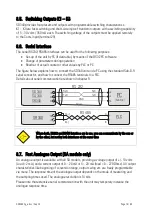
SD34002g_e.doc / Sep-13
Page 9 / 60
3.1. Power Supply
The SD340 counter accepts both, a 17 – 40 volts DC power or a 24 volts AC power (+/-10%)
for supply via terminals 17 and 1. The current consumption depends on the level of the input
voltage and some internal conditions; therefore it can vary in a range from 100 – 200 mA
(aux. currents taken from the unit for encoder supply not included).
3.2. Auxiliary Outputs for Encoder Supply
Terminals 2 and 18 provide an auxiliary output with approx. +5.2 volts DC (300 mA totally).
Terminals 3 and 19 provide an auxiliary output with approx. +24 volts DC (240 mA totally)
3.3. Impulse Inputs for Incremental Encoders
All input characteristics of the impulse inputs can be set by the parameter menu, for each of
the encoders separately. Depending on the application the unit can accept single channel
information (input A only without direction signal) or dual channel signals (A = step and B =
direction) or quadrature information (A / B, 90°). The following settings are possible:
Symmetric input (differential A, /A, B, /B) according to RS422 standard
TTL inputs at a level of 3.0 to 5 volts (differential, with inverted signal)
TTL inputs at a level of 3.0 to 5 volts (single-ended) *)
HTL signals at a 10 – 30 volts level
(alternatively differential with inverted signals A, /A, B, /B, or single-ended A, B only)
Impulses from photocells or proximity switches etc. providing a HTL level (10 – 30 volts)
Proximity switches according to NAMUR (2-wire) standard
(may need additional remote resistor)
*) requires special settings of the threshold parameters, see “Special parameters F08”
All encoder input lines are internally terminated by pull-down resistors ( 8,5 k
Ω
).
Where encoders with pure NPN outputs are used, corresponding pull-up resistors must be
available inside the encoder or externally to ensure proper function (1 k
Ω
... 3,3 k
Ω)
.
3.4. Control Inputs Cont.1 – Cont.4
These inputs can be configured for various remote functions as described under 6.2.4.
All control inputs require HTL level. They can be individually set to either NPN (switch to -) or
PNP (switch to +) characteristics. For applications where edge-triggered action is needed, the
menu allows to set the active edge (rising or falling). Control inputs also accept signals with
Namur (2-wire) standard.
For reliable operation the minimum pulse width on the control inputs should be 50 µsec.










































